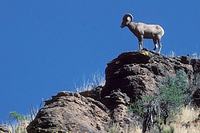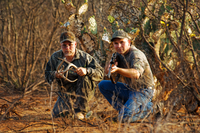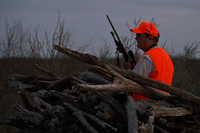You Are Getting Ready to Carry a Firearm on a Boat. What Is the First Step You Should Take
Whenever a firearm is involved with any activeness, in that location is a potential for an accident to occur when the firearm is not handled responsibly. How to be a safety hunter is not something you learn one time. Hunting safety should be an ongoing evolution of skills and attitude over the lifetime of the hunter.
Rules Hunters Tin Live By . . . Ten Commandments of Shooting Condom
- Always point the muzzle in a safe direction.
Command the direction of the muzzle at all times. Do not signal a firearm or bow at annihilation you do not intend to shoot. Never residual a muzzle on your toe or foot. Keep your finger out of the trigger guard until the instant yous are ready to fire. Always proceed the safe on until ready to fire; still, the prophylactic should never be a substitute for safe firearm handling. - Treat every firearm or bow with the aforementioned respect yous would evidence a loaded gun or nocked arrow.
Every fourth dimension you lot pick upwards a firearm, the first affair you do is signal the cage in a safe direction and check to run into if information technology is loaded. Be certain the bedchamber and mag are empty and that the action is open until ready to be fired. If you practise not sympathize how to decide if information technology is loaded, do not accept the firearm until someone has safely shown you that it is unloaded. Read your educational activity manual carefully before you handle new firearms or bows. - Be sure of your target and what is in front end of and across your target.
Before yous pull the trigger you must properly place game animals. Until your target is fully visible and in adept light, do not even raise your scope to see it. Apply binoculars! Know what is in front of and behind your target. Determine that you lot have a safe backstop or background. Since yous do not know what is on the other side, never take a shot at any animals on superlative of ridges or hillsides. Know how far bullets, arrows and pellets can travel. Never shoot at flat, hard surfaces, such every bit water, rocks or steel because of ricochets. - Unload firearms and unstring conventional bows when not in utilize.
Leave actions open, and store sporting arms in cases when traveling to and from shooting areas. Take bolts out or suspension downwardly shotguns if necessary. Know how your equipment operates. Shop and transport firearms and ammunition separately and under lock and key. Store firearms and bows in cool, dry places. Utilize gun or trigger locks and guards when not in employ. - Handle the firearms, arrows and armament carefully.
Avoid horseplay with firearms. Never climb a fence, a tree or a ladder with a loaded firearm or bow and arrows. Never jump a ditch or cantankerous hard terrain with a loaded firearm or nocked pointer. Never confront or look down the butt from the cage cease. Be sure the only ammunition you behave correctly matches the gauge or caliber you are shooting. Always carry arrows in a protected embrace or quiver. Acquire the proper carries. Endeavour to use the two-paw carry whenever possible because information technology affords you the all-time cage control. Always carry handguns with hammers over an empty chamber or cylinder. If you autumn, be sure to disassemble the gun and bank check the barrel from the breech end for obstructions. Carry a field cleaning kit. - Know your safe zone-of-burn and stick to it.
Your safe zone-of-fire is that area or direction in which you can safely fire a shot. Information technology is "down range" at a shooting facility. In the field it is that mental epitome you lot draw in your heed with every step you take. Be certain you know where your companions are at all times. Never swing your gun or bow out of your safe zone-of-burn down. Know the rubber carries when there are persons to your sides, in forepart of, or behind you. If in doubt, never take a shot. When hunting, wear daylight fluorescent orange so you can be seen from a distance or in heavy cover. - Command your emotions when it comes to safety.
If you lot lose control of your emotions you lot may do something carelessly. If you have merely shot a target or animal you probably will exist excited. At that moment you may turn with a loaded firearm dorsum towards your friends or y'all might run with a loaded firearm towards a downed animal with the gun safe off. You or someone else may be in anger in one case y'all lose command of your emotions. Show field of study. Rehearse in your listen what the safe actions volition be. Do not allow your daydreams to supercede good judgment. Evidence restraint and pass up shots which have the slightest gamble of being unsafe. - Wear hearing and eye protection.
While shooting at the range, you must wear hearing and heart protection at all times. Firearms are loud and can create noises which are damaging to a person's hearing. It can exist a gradual loss of hearing due to outbursts of racket over many years. The damage could also exist immediate, peculiarly if your ears are next to a cage blast. Vibrations from the blast are enough to create loss of hearing. Vesture glasses to protect your eyes from escaping gases, burnt powder (especially in blackpowder shooting), and other debris. - Don't drink alcohol or take drugs before or while handling firearms or bow and arrows.
Booze and drugs impair normal physical and mental body functions and mustn't be used before or while handling firearms or archery equipment. These substances affect emotions, making information technology easier to lose control. - Be aware of additional circumstances which crave added caution or safety sensation.
Simply because something isn't listed under these "ten commandments of shooting prophylactic" doesn't hateful y'all tin can ignore it if information technology is unsafe. There may exist rules such as in muzzleloading or archery or posted at a shooting range which should also be followed. Also, practice reloading safety past following and reading all specific instructions. Do all commandments of shooting safety. Ensure a safe time to come for yous, others and the shooting sports.
Watch a video on: the Four Fundamental Firearm Prophylactic Rules .


Never take a shot at game on the crest of a hill. You cannot be sure of what lies beyond the target then do not take the shot.

 Never shoot at a sound or movement. Information technology is a lapse of hunter judgment to mistake another person for a game brute.
Never shoot at a sound or movement. Information technology is a lapse of hunter judgment to mistake another person for a game brute.
In the depression light of dawn or dusk, positive identification of your target can be difficult. If information technology is dawn, wait for better light to be sure at what you are shooting. If it is sunset, pass on the shot and come back in the morning for a safer shot! Remember, always use binoculars to identify your target.
Common Causes of Hunting Accidents
HUNTER JUDGMENT
- Victim out of sight /moved into shooter's line of burn down
- Victim covered by shooter swinging on game
- Victim mistaken for game
- Horseplay with loaded firearm
- Use of alcohol or drugs
CARELESS HANDLING
- Improper Loading/Unloading gun
- Dropped firearm
- Discharge of firearm in or effectually vehicle
- Improper crossing of an obstacle
- Walking with loaded firearm
Source: https://tpwd.texas.gov/education/hunter-education/online-course/hunting-safety
0 Response to "You Are Getting Ready to Carry a Firearm on a Boat. What Is the First Step You Should Take"
Post a Comment